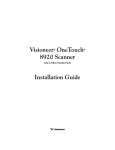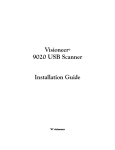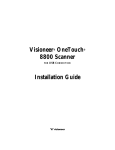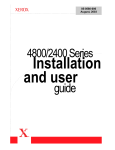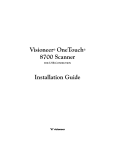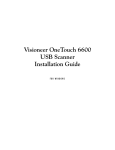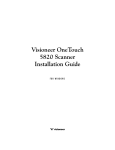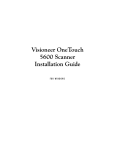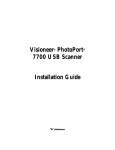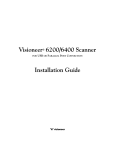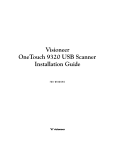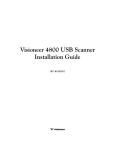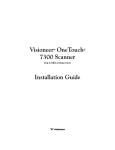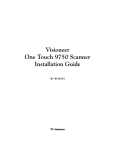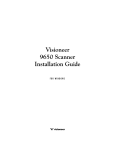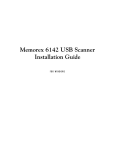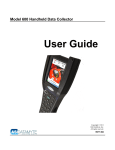Download Visioneer Scanner 9000 User's Manual
Transcript
Visioneer® 9000 USB Scanner Installation Guide COPYRIGHT INFORMATION Copyright © 2002 Visioneer, Inc. Reproduction, adaptation, or translation without prior written permission is prohibited, except as allowed under the copyright laws. The Visioneer brand name and logo are registered trademarks of Visioneer, Inc. The PaperPort brand name and logo are registered trademarks of ScanSoft, Inc. Microsoft is a U.S. registered trademark of Microsoft Corporation. Windows is a trademark of Microsoft Corporation. TextBridge is a registered trademark of ScanSoft, Inc. ZyINDEX is a registered trademark of ZyLAB International, Inc. ZyINDEX toolkit portions, Copyright © 1990-1998, ZyLAB International, Inc. All Rights Reserved. All other products mentioned herein may be trademarks of their respective companies. Information is subject to change without notice and does not represent a commitment on the part of Visioneer. The software described is furnished under a licensing agreement. The software may be used or copied only in accordance with the terms of such an agreement. It is against the law to copy the software on any medium except as specifically allowed in the licensing agreement. No part of this document may be reproduced or transmitted in any form or by any means, electronic or mechanical, including photocopying, recording, or information storage and retrieval systems, or translated to another language, for any purpose other than the licensee's personal use and as specifically allowed in the licensing agreement, without the express written permission of Visioneer. Part Number: 05-0494-000 Restricted Rights Legend Use, duplication, or disclosure is subject to restrictions as set forth in contract subdivision (c)(1)(ii) of the Rights in Technical Data and Computer Software Clause 52.227-FAR14. Material scanned by this product may be protected by governmental laws and other regulations, such as copyright laws. The customer is solely responsible for complying with all such laws and regulations. Visioneer's Limited Product Warranty If you find physical defects in the materials or the workmanship used in making the product described in this document, Visioneer will repair, or at its option, replace, the product at no charge to you, provided you return it (postage prepaid, with proof of your purchase from the original reseller) during the 12-month period after the date of your original purchase of the product. THIS IS VISIONEER'S ONLY WARRANTY AND YOUR EXCLUSIVE REMEDY CONCERNING THE PRODUCT, ALL OTHER REPRESENTATIONS, WARRANTIES OR CONDITIONS, EXPRESS OR IMPLIED, WRITTEN OR ORAL, INCLUDING ANY WARRANTY OF MERCHANTABILITY, FITNESS FOR A PARTICULAR PURPOSE OR NON-INFRINGEMENT, ARE EXPRESSLY EXCLUDED. AS A RESULT, EXCEPT AS SET OUT ABOVE, THE PRODUCT IS SOLD “AS IS” AND YOU ARE ASSUMING THE ENTIRE RISK AS TO THE PRODUCT'S SUITABILITY TO YOUR NEEDS, ITS QUALITY AND ITS PERFORMANCE. IN NO EVENT WILL VISIONEER BE LIABLE FOR DIRECT, INDIRECT, SPECIAL, INCIDENTAL OR CONSEQUENTIAL DAMAGES RESULTING FROM ANY DEFECT IN THE PRODUCT OR FROM ITS USE, EVEN IF ADVISED OF THE POSSIBILITY OF SUCH DAMAGES. All exclusions and limitations in this warranty are made only to the extent permitted by applicable law and shall be of no effect to the extent in conflict with the express requirements of applicable law. FCC Radio Frequency Interference Statement This equipment has been tested and found to comply with the limits for the class B digital device, pursuant to part 15 of the FCC Rules. These limits are designed to provide reasonable protection against interference in a residential installation. This equipment generates, uses and can radiate radio frequency energy and if not installed, and used in accordance with the instructions, may cause harmful interference to radio communications. However, there is no guarantee that interference will not occur in a particular installation. If this equipment does cause harmful interference to radio or television reception, which can be determined by turning the equipment off and on, the user is encouraged to try and correct the interference by one or more of the following measures: • Reorient or relocate the receiving antenna. • Increase the separation between the equipment and receiver. • Connect the equipment into an outlet on a circuit different from that to which the receiver is connected. • Consult the dealer or an experienced radio/TV technician for help. This equipment has been certified to comply with the limits for a class B computing device, pursuant to FCC Rules. In order to maintain compliance with FCC regulations, shielded cables must be used with this equipment. Operation with non-approved equipment or unshielded cables is likely to result in interference to radio and TV reception. The user is cautioned that changes and modifications made to the equipment without the approval of manufacturer could void the user's authority to operate this equipment. This device complies with part 15 of the FCC Rules. Operation is subject to the following two conditions: (1) This device may not cause harmful interference, and (2) this device must accept any interference received, including interference that may cause undesired operation TABLE OF CONTENTS i TA B L E O F C O N T E N T S Welcome . . . . . . . . . . . . . . . . . . . . . . . . . . . . . . . . . . . . . . . . . . . . . . 1 What’s in the Box . . . . . . . . . . . . . . . . . . . . . . . . . . . . . . . . . . . . . . . 1 The Visioneer 9000 USB Scanner . . . . . . . . . . . . . . . . . . . . . . . . . . . 2 What You Need . . . . . . . . . . . . . . . . . . . . . . . . . . . . . . . . . . . . . . . . . 4 INSTALLING . . . . . . . . . . . . . . . . . . . . . . . . . . . . . . . . . . . . . . . . . . 5 STEP 1: Installing the PaperPort Software . . . . . . . . . . . . . . . . . . . . . 5 STEP 2: Connecting the Scanner . . . . . . . . . . . . . . . . . . . . . . . . . . . . 7 Getting the PaperPort Software User’s Guide . . . . . . . . . . . . . . 10 STEP 3: Checking Out Your Scanner . . . . . . . . . . . . . . . . . . . . . . . 10 If the Scanner Is Not Properly Connected . . . . . . . . . . . . . . . . . 11 SCANNING . . . . . . . . . . . . . . . . . . . . . . . . . . . . . . . . . . . . . . . . . . 13 Three Ways to Scan Paper Items . . . . . . . . . . . . . . . . . . . . . . . . . . . 13 Scanning Paper Items with the OneTouch Buttons . . . . . . . . . . . . . 14 About the OneTouch Buttons . . . . . . . . . . . . . . . . . . . . . . . . . . 15 Scanning Paper Items from the Button Panel on the Screen . . . . . . 16 Configuring the Scanner . . . . . . . . . . . . . . . . . . . . . . . . . . . . . . . . . 17 About the Configuration Dialog Box . . . . . . . . . . . . . . . . . . . . . 18 Getting Help . . . . . . . . . . . . . . . . . . . . . . . . . . . . . . . . . . . . . . . 20 Selecting New Options for the Buttons . . . . . . . . . . . . . . . . . . . 21 Creating New Configurations . . . . . . . . . . . . . . . . . . . . . . . . . . 22 Adjusting Scan Settings and Page Settings . . . . . . . . . . . . . . . . . 22 Setting Preferences . . . . . . . . . . . . . . . . . . . . . . . . . . . . . . . . . . . 26 Scanning from the PaperPort Software . . . . . . . . . . . . . . . . . . . . . . 29 Scanning an Item with the Twain Button . . . . . . . . . . . . . . . . . 30 Getting Help with the PaperPort Software . . . . . . . . . . . . . . . . 34 Adjusting the Settings on the Scan Manager Pro . . . . . . . . . . . . . . . 35 Saving a New Profile . . . . . . . . . . . . . . . . . . . . . . . . . . . . . . . . . 36 Adjusting the Resolution and Sharpness . . . . . . . . . . . . . . . . . . 38 Adjusting the Brightness and Contrast . . . . . . . . . . . . . . . . . . . 39 ii TABLE OF CONTENTS Adjusting Gamma, Saturation, and Color Hue . . . . . . . . . . . . . 41 Adjusting Output Size . . . . . . . . . . . . . . . . . . . . . . . . . . . . . . . . 43 Saving a Custom Size . . . . . . . . . . . . . . . . . . . . . . . . . . . . . . . . 47 The Scan Info Box . . . . . . . . . . . . . . . . . . . . . . . . . . . . . . . . . . . 48 Zooming In and Out . . . . . . . . . . . . . . . . . . . . . . . . . . . . . . . . . 48 Setting Preferences . . . . . . . . . . . . . . . . . . . . . . . . . . . . . . . . . . . 49 Getting Help with the Scan Manager Pro . . . . . . . . . . . . . . . . . 51 Troubleshooting . . . . . . . . . . . . . . . . . . . . . . . . . . . . . . . . . . . . . . . 52 Cleaning the Scanner Glass . . . . . . . . . . . . . . . . . . . . . . . . . . . . . . . 53 How to Uninstall Your Scanner . . . . . . . . . . . . . . . . . . . . . . . . . . . . 54 Step 1: Uninstalling the Visioneer OneTouch Software . . . . . . . 54 Step 2: Uninstalling the PaperPort Software . . . . . . . . . . . . . . . 57 Contacting Visioneer America Technical Support . . . . . . . . . . . . . . 58 Contacting Visioneer—International Technical Support . . . . . . . . . 59 Visioneer PhotoPort 9000 USB Scanner Specifications . . . . . . . . . . 60 Index . . . . . . . . . . . . . . . . . . . . . . . . . . . . . . . . . . . . . . . . . . . . . . . . 61 WELCOME Congratulations on purchasing your Visioneer 9000 USB scanner. With this scanner you can quickly scan paper items such as letters, forms, photos, and magazine articles and place their electronic images on your computer. WHAT’S IN THE BOX Please check the contents of the box to make sure that all parts are included. If any items are missing or damaged, contact the dealer where you purchased the scanner. Visioneer 9000 USB Scanner Software CD Installation Guide USB Cable Power supply VISIONEER 9000 USB SCANNER INSTALLATION GUIDE 1 2 VISIONEER 9000 USB SCANNER INSTALLATION GUIDE THE VISIONEER 9000 USB SCANNER Document cover Glass Reference marks OneTouch buttons panel Status light OneTouch buttons Custom scan Scan and email Scan and print Scan and OCR Scan to PaperPort USB port Power jack THE VISIONEER 9000 USB SCANNER 3 Document cover. Close the document cover after placing items on the scanner glass. Glass. Place items face down on the glass aligned at the arrow symbol in the upper left corner. Reference marks. Marks on the border of the glass show where to align various paper sizes. OneTouch button panel. Press a OneTouch button to scan, copy/print, email, OCR (convert items to text), or use a custom setting for scanning. Status light. Shows the scanner’s status. Green light: scanner is ready to scan. Orange light: scanner is busy. USB port. Plug one end of the USB cable into this port; plug the other end into a USB port on the computer, keyboard, or a USB hub. Your Visioneer 9000 scanner can connect to either a USB 1.1 or a USB 2.0 port. Power jack. Plug the scanner power cord into this jack. Note: The scanner does not have an on/off switch. The scanner is ready to scan as soon as Windows loads on your computer. 4 VISIONEER 9000 USB SCANNER INSTALLATION GUIDE WHAT YOU NEED To use the 9000 OneTouch scanner and software, you need the following: ■ IBM PC (or 100-percent compatible) Pentium or equivalent ■ Microsoft Windows 98, Windows 2000, Windows Me, or Windows XP ■ One available Universal Serial Bus (USB) port; the scanner can connect to either a USB1.1 or to a faster USB 2.0 port (see the note below) ■ Available internal memory (RAM): ■ Windows 98—32 megabytes (MB) or more ■ Windows 2000, Me, or XP—64 MB or more; 128 MB recommended for Windows XP ■ 70 MB of free hard disk space ■ A VGA or SVGA monitor. Recommended settings for your monitor are as many colors as possible—High Color (16-bit), True Color (24-bit or 32-bit). Set the resolution to at least 800 by 600 pixels. To set your monitor’s colors and resolution, open the Windows Control Panel, double-click Display, and then click the Settings tab. ■ A CD-ROM drive Note: The new USB 2.0 ports operate at higher speeds than USB 1.1 ports. If your computer is not equipped with USB 2.0 ports, you can add them with the Visioneer Hi-Speed USB 2.0 PCI Card. Please visit the Visioneer web site at www.visioneer.com for ordering information, or contact the dealer where you purchased your Visioneer 9000 OneTouch USB scanner. However, you do not have to add USB 2.0 ports to the computer. Your scanner automatically works with both USB 1.1 and USB 2.0 ports. STEP 1: INSTALLING THE PAPERPORT SOFTWARE 5 Installing This section of the guide explains how to connect your Visioneer 9000 scanner to a USB 1.1 or USB 2.0 port. The PaperPort CD includes all the necessary installation files, as well as the PaperPort software files and other software files. STEP 1: INSTALLING THE PAPERPORT SOFTWARE Note: You must install the PaperPort software before connecting the scanner to the computer. Otherwise the correct software to run your scanner will not be installed and it may not scan properly. To install the PaperPort software: 1. Start your computer and make sure that no other applications are running. 2. Insert the PaperPort CD into your computer’s CD-ROM drive. The CD automatically starts. 6 VISIONEER 9000 USB SCANNER INSTALLATION GUIDE Note: If the PaperPort CD does not automatically start, make sure the CD drive’s door is completely shut. If the CD still doesn’t start, the Autorun option on your computer is turned off. Click the Windows icon named My Computer. The window shows the drives available on your computer. Double-click the icon for your CD-ROM drive to see the list of files on the CD. Double-click the file named START32.EXE. The CD starts. 3. From the list of options that appears on the screen, select ScanSoft PaperPort. 4. Select Install ScanSoft PaperPort. 5. Follow the instructions on the screen to install the PaperPort software on your computer. During installation, a message instructs you to connect the scanner to the computer. When you’re finished connecting the scanner as described below, click Finish in the dialog box. STEP 2: CONNECTING THE SCANNER STEP 2: CONNECTING THE SCANNER Your OneTouch 9000 scanner connects to any available USB 1.1 or USB 2.0 port. Check your computer’s user’s guide for its USB port locations. Note: You do not have to shut off the power to your computer when connecting the scanner to a USB port. To connect the Visioneer 9000 scanner to a USB 1.1 or USB 2.0 port: 1. Turn the scanner over to see the locking tab on the bottom. Slide the locking tab to the unlocked position. Unlocked position Note: The locking tab protects the scanner’s scan head by holding it securely in position. Lock the scanner when transporting it from one location to another, but always remember to unlock it before scanning. The scanner will not scan when locked. 7 8 VISIONEER 9000 USB SCANNER INSTALLATION GUIDE 2. Plug one end of the USB cable into an available USB 1.1 or USB 2.0 port on the computer. 3. Plug the other end of the USB cable into the scanner’s USB port. USB If the plug does not attach easily, make sure that you are plugging it in correctly. Do not force the plug into the connection. Some computers also have keyboards with USB ports. You can plug the cable into the keyboard instead of the USB port on the computer. 4. Plug the power adapter cable into the power jack on the back of the scanner. 5. Plug the power adapter into an AC (wall) outlet. The following diagram shows the scanner connected to a computer. STEP 2: CONNECTING THE SCANNER 9 The status light on the front of the scanner comes on indicating the scanner is receiving power. Status light Your computer recognizes that a scanner has been plugged into the USB port and automatically loads the appropriate software from the CD to run the scanner. Note: If your computer is running Windows XP, you may see messages about using a fast USB 2.0 connection for your scanner. If your computer is not equipped with USB 2.0 ports, you can just disregard those messages. When the software is finished loading, the Finish button on the dialog box on the computer screen becomes active. 6. Click the Finish button. The scanner’s status light is green when the scanner and computer are communicating properly. That completes the steps to connect your scanner to the computer. 7. Click Yes, I want to restart my computer now. 8. Click Finish. Your computer restarts and your scanner is now ready to scan. 9. If you removed the CD from the CD drive and want to install other software, reinsert the CD into the drive. Remove the CD from the computer when you’re finished and store it in a safe place. 10 VISIONEER 9000 USB SCANNER INSTALLATION GUIDE GETTING THE PAPERPORT SOFTWARE USER’S GUIDE The Installation CD also includes your ScanSoft PaperPort User’s Guide. This guide provides more detailed information about the PaperPort software’s features. Please see the CD to view or print the guide. STEP 3: CHECKING OUT YOUR SCANNER The OneTouch software adds the scanner icon to the Windows taskbar (at the bottom right corner of the computer screen). If the scanner is properly connected, the scanner icon looks like the one in this figure. Scanner Icon If the icon has a red X through it, the scanner is not properly connected. See the section, “If the Scanner Is Not Properly Connected” on page 11 for the steps to fix the problem. To check the status of the scanner: 1. Place the mouse pointer on the scanner icon in the Windows taskbar. 2. Right-click the icon. The shortcut menu appears. STEP 3: CHECKING OUT YOUR SCANNER 11 3. Choose About from the shortcut menu. A dialog box confirms that the scanner is properly connected. 4. Click OK to close the dialog box. Your scanner is ready to scan. IF THE SCANNER IS NOT PROPERLY CONNECTED If the scanner icon on the Windows taskbar has a red “X” through it, the scanner is not properly connected. Check for one of these possible problems: • Is a cable loose or not plugged in securely? Inspect all cable connections. Make sure all the cables are plugged in securely. • Is the scanner’s power light on? If the light does not come on, plug the power adapter into another electrical outlet. • Is the scanner’s locking tab in the locked position? Slide the locking tab to the unlocked position. If you tried to scan with the scanner locked, you must restart your computer after unlocking the scanner. • Did you restart the computer after installing the software? If you didn’t restart the computer, it may not have loaded all of the software files. Try restarting your computer. 12 VISIONEER 9000 USB SCANNER INSTALLATION GUIDE Please see the Readme file in the PaperPort directory on your computer’s hard drive. The Readme file contains additional information that may help you diagnose problems connecting the scanner. Also see “Troubleshooting” on page 52 for more information. Note: The scanning lamp under the scanner’s glass needs to warm up before you can scan. A status message lets you know when the lamp is ready. The lamp then remains ready so you don’t have to wait each time you want to scan. To conserve electricity and prolong the life of the scanner, you can set the length of time for the lamp to remain lit before powering down. See “Setting Preferences” on page 26. To connect the scanner: 1. After checking for all the above problems, right-click the scanner icon with the red X over it. The shortcut menu appears. 2. Choose Connect from the shortcut menu. The software finds the scanner and makes the connection. The scanner icon will no longer have a red X through it, and you’re ready to begin scanning. If you try all the troubleshooting procedures described above and in the Readme file, and the scanner icon still has a red X through it, you may have a malfunctioning scanner. Please see “Contacting Visioneer America Technical Support” on page 58 or “Contacting Visioneer— International Technical Support” on page 59. Also visit our web site at www.visioneer.com for additional technical information. You can also receive software updates from the Windows Start menu by choosing Programs, then PaperPort, then Check for OneTouch Updates. THREE WAYS TO SCAN PAPER ITEMS 13 Scanning THREE WAYS TO SCAN PAPER ITEMS You can scan paper items by pressing a OneTouch button, by clicking a button on the screen, or from the PaperPort software. • Scan with the Scanner Buttons Press a button on the scanner’s front panel. • Scan from the Screen Click the scanner icon on the Windows taskbar. A panel representing the scanner buttons appears. Click a button on the panel. • Scan from the PaperPort Software (or Other Twain Software) Start the PaperPort software, then click the Twain icon on the PaperPort Command Bar. You can also scan from other Twain software. See “Scanning from the PaperPort Software” on page 29. 14 VISIONEER 9000 USB SCANNER INSTALLATION GUIDE SCANNING PAPER ITEMS WITH THE ONETOUCH BUTTONS Pressing a scanner button scans the item, and then sends the image either to the printer or to a software application on your computer. To scan by pressing a OneTouch button on the scanner: 1. Place an item to scan on the glass, face down, and align the edge of the item with the arrow marker at the upper left corner of the glass. 2. Close the document cover and press one of the OneTouch buttons. The scanner starts scanning the item. Messages just above the Windows taskbar show the status of the scanning. During scanning, the scan progress window shows a small copy of the image, as illustrated by this example: When the scan is complete, the scanned image appears in the destination software, in this case the PaperPort desktop. SCANNING PAPER ITEMS WITH THE ONETOUCH BUTTONS 15 ABOUT THE ONETOUCH BUTTONS The OneTouch buttons are preconfigured for typical scanning tasks. To change the settings for the buttons, see “About the Configuration Dialog Box” on page 18. The following table lists the OneTouch buttons’ preconfigured settings: Button Function Preconfigured Settings Scan Scans the item as color page and displays it in PaperPort Email Scans the item as a color photo and attaches it to a new email message in your email application OCR Converts the item’s text to black and white word processing text, and displays it in a word processing application Copy/Print Prints the scanned item in black and white on your printer/copier at the printer/ copier’s default resolution Custom Scans the item as a color photo and displays it in an image processing application Note: If a button is not preconfigured, the Configuration dialog box appears when you press that button so you can configure it manually. For example, if your computer does not have email software installed, the email button cannot be preconfigured. 16 VISIONEER 9000 USB SCANNER INSTALLATION GUIDE SCANNING PAPER ITEMS FROM THE BUTTON PANEL ON THE SCREEN Scanning from the button panel on the screen is just like pressing a scanner button, except you click the button on the screen. The scanner scans the item, and then sends the image either to the printer, or to a software application on your computer. This method of scanning is especially helpful if the scanner is not located close to your computer. To scan from the screen: 1. Place an item to scan on the glass, face down, close the document cover, and click the scanner icon on the Windows taskbar. The scanner button panel appears on the screen. 2. Click the button you want to use to scan. The scanner starts scanning the item. When the scan is complete, the scanned image appears in the destination application. 3. To close the button panel, click the scanner icon in the panel’s upper left corner. The icons on the buttons indicate the destination application for the scanned image. For example, in the illustration above, the icon on the email button is for the email application, MS Outlook. When you click the email button, the item is scanned, and then MS Outlook opens. In this case, the scanned image automatically becomes an attachment to send with an email message. A question mark icon on a button means your computer does not have an application that corresponds to that button’s functions. For example, if your computer does not have an email application, the email button will have a question mark icon on it. CONFIGURING THE SCANNER 17 CONFIGURING THE SCANNER When you first connect your scanner to a computer, the scanner’s software configures each OneTouch button with appropriate settings. But, if you want to change the settings, you can reconfigure the buttons by selecting new options from the Configuration dialog box. You display the Configuration dialog box from either the shortcut menu or the Button Panel. To display the Configuration dialog box from the shortcut menu: 1. Right-click the scanner icon. Scanner icon The shortcut menu appears. 2. Choose Configure on the shortcut menu. The Configuration dialog box appears. Click the tab that corresponds to the button you want to configure. 18 VISIONEER 9000 USB SCANNER INSTALLATION GUIDE To display the Configuration dialog box from the Button Panel: 1. Right-click the button you want to configure. The Configuration dialog box appears. The tab for the scan button you clicked is selected for you. ABOUT THE CONFIGURATION DIALOG BOX The Configuration dialog box shows the current settings for each scanner button. The tabs across the top of the dialog box correspond to the buttons. Clicking a tab shows the current settings for the corresponding button on the scanner. For example, the highlighted selections in the following figure show the current settings for the Custom button because the Custom tab is selected. The Custom button is set up to scan the item with the configuration named Photograph for Editing, and then after the scanning is finished, to open Microsoft Paint to display the scanned image. The Format and Page(s) setting is to scan as a bitmap for a single page item. CONFIGURING THE SCANNER 19 Click this tab to set preferences. Click the tab that corresponds to the scanner button you want to configure. Select a setting for scanning the item. Select a software application to send the scanned image to that application. Select format and page(s) options for the button. See “Setting Preferences” on page 26 to set Preferences. The options on the Configuration dialog box are: Select Destination—the list of applications that can open to display the scanned image. Select the application that you want to automatically open to display or process the scanned image. Select Configuration—the list of the button’s scan configurations. The configuration settings include: color, black and white, or grayscale, resolution in dots per inch (dpi), page size, brightness, and contrast. To see the details about a configuration, click its icon in the list. Click the icon again to close the detailed information. Clicking an icon expands the configuration to show its settings 20 VISIONEER 9000 USB SCANNER INSTALLATION GUIDE Select Format and Page(s)—displays a set of options for selecting a format for the scanned image and whether to scan a single page or multiple pages. The formats are bitmap and PaperPort. Use PaperPort for scanning any item. Bitmaps are usually for photos or artwork. The page icons represent single or multiple page scanning. Scan single page Scan multiple pages Scan multiple pages and stack them on the PaperPort Desktop Options—displays a dialog box for selecting options about the destination application for the scanned image. Each destination application has its own options dialog box. Folder Copy—displays a dialog box for selecting the folder to use for storing copies of the scanned images. GETTING HELP You can get help with the scanner’s features or any of the options on the Configuration dialog box using either of the following methods: ■ When the Configuration dialog box is displayed, press the F1 key on your keyboard ■ Click the Help button at the top right corner of the Configuration dialog box Help button CONFIGURING THE SCANNER 21 SELECTING NEW OPTIONS FOR THE BUTTONS You can select a new destination application, configuration, and image format for a scanner button to optimize it for the type of scanning you want to do. You use the Configuration dialog box to select new options. To select new options for a scanner button: 1. Display the Configuration dialog box. Click the tab of the button whose options you want to change. 2. Scroll the list of applications in the Select Destination list and click the new application you want to use to view and work with the scanned image. Note: If you select a word processing program such as Microsoft Word and a configuration for OCR, text in scanned images is automatically converted to editable text by the optical character recognition software that you receive with the scanner. The converted text then appears in the selected destination application. 3. Click a selection in the Select Configuration list to choose a new scan configuration for the selected scanner button. The configurations are preset for the application you select in the application list. If you select another application, the configurations are for that application. 4. Select one of the Format and Page(s) options for the button. 5. Click OK. Now when you press the scanner button, it scans the image using the new configuration settings and displays the scanned image in the new destination application. Note: If you want to scan using the Visioneer Scan Manager Pro, click the option, Configure before Scan. Now when you press the selected scanner button, the Visioneer Scan Manager Pro appears first and you can use it to scan. 22 VISIONEER 9000 USB SCANNER INSTALLATION GUIDE CREATING NEW CONFIGURATIONS You cannot change settings such as brightness or contrast of the preset configurations. To scan with settings other than those offered by the preset configurations, you must first create a new configuration and then use it to scan. To create a new configuration click the New button. You can also click Copy to copy a preset configuration, change its settings, and then save it under a new configuration name. To see Help for creating a new configuration press the F1 key on your keyboard. ADJUSTING SCAN SETTINGS AND PAGE SETTINGS When scanning using a configuration that you created yourself, you can adjust that configuration’s scan settings and page settings. For example, if the scanned image is too dark, you can adjust the brightness of the scan setting. Note: You cannot change the scan settings or page settings for any of the predefined scan configurations. You can only adjust settings for scan configurations that you create yourself. See the section above, “Creating New Configurations”. To adjust the scan settings and page settings: 1. Display the Configuration dialog box. Click the tab of the button whose options you want to change. CONFIGURING THE SCANNER 23 2. In the Select Configuration list, click the configuration that you want to adjust. For example, the following figure shows a configuration named Special Scan for Dark Print (which you would have created earlier). 3. Click the Edit button. The dialog box appears for adjusting the scanning settings of the selected configuration. 24 VISIONEER 9000 USB SCANNER INSTALLATION GUIDE 4. Adjust the scan settings that you want. Mode—Select Black/White to scan in black and white. For example, letters and memos are usually scanned in black and white. Select Grayscale to scan items such as documents containing drawings or black and white photographs. The scanning produces an image in varying shades of gray. Select Color to scan color photographs and other color items. Resolution—Drag the slider to the right or left to adjust the dots per inch (dpi) of the resolution. The maximum resolution is 1200 dpi; the minimum is 50 dpi. The higher the dpi setting, the sharper and clearer the scanned image. However, higher dpi settings take longer to scan and produce larger files for the scanned images. Brightness and Contrast—Drag the sliders to the right or left to adjust the brightness and contrast of the scanned image. The Contrast setting does not apply to the Black/White mode. 5. Click the Page Settings tab to adjust the scan page settings. Page Size—Choose a page size from the drop-down list. The outlines on the picture represent the various page sizes. Clicking one of those outlines also selects it as the page size for the scan. If you select the Custom option from the drop-down list, boxes appear in place of the picture. Enter the horizontal and vertical page dimensions in the boxes. CONFIGURING THE SCANNER 25 AutoCrop—Select this option to let the scanner automatically determine the size of the item being scanned. For example, if you put a photo in the middle of the glass, the scanner will automatically determine the size of the photo. When AutoCrop is selected, the scanner makes two passes—the first pass senses the item’s size, and the second pass scans the image. This option overrides the Page Size menu selection. DeScreen—Select this option when scanning a picture from a newspaper or magazine article, or other items that contain images with patterns or dots. Scans of patterns or dots sometimes have a distorted or wavy appearance. The scanner scans the item to compensate for the patterns and dots, and produces a clearer image. The scanning may slow down a bit when this option is selected. You don’t need to select this option when scanning photographs. The DeScreen setting does not apply to the Black/White mode. Gamma—Drag the slider to improve how the colors in a scanned image look on your monitor. Gamma correction allows you to achieve precise color matching. Because the computer cannot always transmit the exact color information to the hardware, you may have to make some color adjustments using the Gamma feature. The default Gamma setting works fine in most cases and normally does not need to be adjusted. 6. Click OK. The Configuration dialog box reappears. Make sure the configuration you just defined is selected. 7. Click OK on the Configuration dialog box. The new configuration and its adjusted settings now apply to the button whose tab is selected at the top of the Configuration dialog box. Note: If you select the Copy/Print button, the dialog box for editing and adjusting the settings will have a Device tab for selecting options for a printer or copier. See the Help for more information. 26 VISIONEER 9000 USB SCANNER INSTALLATION GUIDE SETTING PREFERENCES The preferences apply to each button and to the scanner. To set preferences: 1. On the Configuration dialog box, select the tab for a button to set its preferences. 2. Click the Preferences tab on the Configuration dialog box. Preferences tab The Preferences dialog box appears. The dialog box shows which button you selected for new preferences. The name of the button to receive new preferences If the Button tab on the Preferences dialog box is not selected, click it. Show All Destinations—Clicking this option automatically selects all the destination applications categories. When you click the button’s tab on the Configuration dialog box, its list of destination applications include all of the applications on your computer that CONFIGURING THE SCANNER 27 fall into these categories. For example, the destination applications for the email button are usually email applications. By selecting the Show All Destinations option as the preference for the email button, all the other types of applications are included in the list of email destination applications. Select Destinations—Select this option to individually choose the types of applications to include in the button’s list of destination applications. Click in the boxes for the types of applications to include in the button’s list. Show Scan Progress Window—Select this option to see the window that shows a rendition of the image during the scanning. See the sample on page 14. 3. Click the General tab to set preferences for the scanner. Show Status Window—Select this option to see the small window at the bottom right corner of the screen that shows the status of the scanning and other information as shown in this sample: 28 VISIONEER 9000 USB SCANNER INSTALLATION GUIDE Show Scanner Icon in Windows Taskbar—Select this option to see the small icon representing the OneTouch scanner in the Windows taskbar. Scanner icon Scanner Lamp turns off—These options control when the scanner lamp powers goes off. After idling for xx minutes—Select this option to automatically turn off the lamp if the scanner hasn’t been used for the specified time. This option saves energy and extends the lamp’s life. Click in the box and enter the number of minutes for the lamp to remain idle before turning off. If you scan when the lamp is off, it warms up before scanning resumes. On System Standby/Shutdown—Select this option to turn off the lamp when you turn off your computer, or when the computer’s energy saver option automatically puts the computer into standby mode. Folder for Temporary Images—Click the Folder button and then select a folder for the scanner’s temporary images. During scanning, a temporary file contains scan information about the image. Because temporary image files can sometimes be large, select a folder that has sufficient disk space available. 4. Click OK. SCANNING FROM THE PAPERPORT SOFTWARE 29 SCANNING FROM THE PAPERPORT SOFTWARE Instead of using a scanner button, you can scan directly from the PaperPort software. To scan transparencies you must scan from the PaperPort software or other Twain software. Note: You can also scan directly with other software that meets the Twain standards for scanning, which includes many graphics and imaging applications available for your computer. The following steps explain how to set up and scan from the PaperPort software but you use the same basic processes with other Twain software. To scan from PaperPort, you must first do a one-time-only set up of the software. To set up the PaperPort software with the scanner: 1. If the PaperPort software isn’t currently running, double-click the PaperPort icon on the Windows desktop to start it. The PaperPort Desktop appears. 2. From the PaperPort File menu, choose Select Source. The Select Source dialog box appears, and lists the Visioneer application (as well as all other Twain devices installed on your computer). 3. Choose Visioneer Scan Manager Pro, and then click Select. Note: You don’t need to set up the scanner again unless you change the source to some other Twain device, such as a digital camera. 30 VISIONEER 9000 USB SCANNER INSTALLATION GUIDE SCANNING AN ITEM WITH THE TWAIN BUTTON The following steps explain how to scan an item using the Twain button in the PaperPort software. You can scan many types of paper items, from small business cards to A4-sized pages. Note: Your Visioneer OneTouch scanner is initially set to scan from the PaperPort software for color items. To scan a black-and-white or greyscale item, select one of the other configurations from the Scan Manager Pro’s list of configurations. To scan at a higher resolution for a color image, select Color—Better Quality. However, scanning at a higher resolution creates a larger file size and takes longer to scan. To minimize the file size and the time required to get a better quality scan, select just the area of the item that you want to scan. To scan an item: 1. Open the scanner cover, place the item face down onto the lower left edge of the scanner glass, and close the cover. 2. If PaperPort isn’t running, double-click the PaperPort icon on the Windows Desktop to start it. The PaperPort Desktop appears. 3. Click the Twain icon on the Command Bar, or choose Acquire from the File menu. Note: You can also scan from other applications that have the Twain capability. See the user’s guides that you received with those applications for their specific steps to scan. The Visioneer Scan Manager Pro appears. SCANNING FROM THE PAPERPORT SOFTWARE 31 Choose a scanning option. Scan Reflective Using is for scanning paper items. The other options are for transparencies. Click an icon to select a configuration—Color, Grey Scale, or Black&White. This example shows the Color/ Custom configuration is selected. Clicking the “+” sign in front of Custom shows Custom’s scan settings as a list. Click a setting in the list if you want to change it. The setting’s options appear on the right side of the Scan Manager Pro where you can select new options if necessary. Check the Scan Info to make sure your computer has sufficient space for the image. Warning icons on this box appear if your computer does not have enough space for the scanned image’s file. Click Preview to see what the image will look like. The Preview image appears in the window. If the image is what you want, click Scan. If not, adjust the settings or select a new configuration and click Preview again. Click AutoScan to scan with your preset scan choices. You can now scan manually by previewing the image and adjusting the scan settings to your liking, or you can click AutoScan. The AutoScan feature uses your preset scan settings and the scanner’s automatic image analysis capabilities to find the optimum combination of settings for the item you’re scanning. Note: The appearance of the Scan Manager Pro window depends on your computer monitor’s screen resolution. Therefore, what you see on your computer screen may be slightly different than the examples shown in this Guide. 32 VISIONEER 9000 USB SCANNER INSTALLATION GUIDE To scan manually: 1. On the Scan Manager Pro, select a configuration for the scan. For example, select Color Configurations and then select Custom to scan a color item with the preset Custom scan settings. That configuration’s settings appear as a list. Click the “+” sign to see the full list of scan settings. Click the “-” (minus) sign to collapse the list. To see the settings for another configuration, click it in the list. For example, to see the Grey Scale settings, click the Grey Scale configuration. 2. Click the Preview button to preview the scanned image before scanning it. The scanner scans the item and displays a preview using the options you selected. 3. Review the image to make sure it’s what you want. 4. To adjust one of the settings for the scan, click it in the list of settings. A panel appears on the right side of the Scan Manager Pro for that setting. Select new options for the setting on that panel. See “Adjusting the Settings on the Scan Manager Pro” on page 35 for more about changing the scan settings. 5. (optional) To preview the image again, click the Preview button. 6. Readjust the settings if necessary. 7. When you’re satisfied with the image settings, click the Scan button. When the scan is complete, the scanner displays the final image as a thumbnail on the PaperPort Desktop. If the item is scanned as a bitmap image, a small bitmap icon appears in the lower left corner of the thumbnail. SCANNING FROM THE PAPERPORT SOFTWARE 33 Thumbnail image Bitmap icon To scan automatically: 1. Click AutoScan. The scanner uses your preselected resolution setting for the configuration you selected. See “Setting Preferences” on page 49 to set the AutoScan settings. In addition, your OneTouch 9000 scanner has built-in image analysis capabilities that find the optimum combination of settings for the item you’re scanning. When you click AutoScan, the scanner analyzes the image and adjusts the settings to produce the optimal scanned image. The following dialog box appears while the scan is in progress. Checkmarks indicate that phase of the process is finished. 34 VISIONEER 9000 USB SCANNER INSTALLATION GUIDE The autoscanned image appears as a thumbnail on the PaperPort Desktop. 2. Use the PaperPort software to work with the image. Please see the PaperPort Getting Started Guide and PaperPort User’s Guide on the CD for more information about using the PaperPort software. GETTING HELP WITH THE PAPERPORT SOFTWARE The PaperPort software includes a complete set of help topics that answer questions about each feature of the software. ■ To see help information, press the F1 key, or from the Help menu, choose PaperPort Help Topics to display the Help Topics window. Tip: Also see the technical support card included with your scanner. ADJUSTING THE SETTINGS ON THE SCAN MANAGER PRO 35 ADJUSTING THE SETTINGS ON THE SCAN MANAGER PRO You can adjust the scan settings on the Visioneer Scan Manager Pro to produce the best possible image. To adjust a setting: 1. Click a setting in the list of settings, or click its corresponding button on the right side of the Scan Manager Pro. Resolution and Sharpen Brightness and Contrast Color (Gamma, Saturation, and Hue) Scan Size Note: The list of scan settings for a configuration only apply to that type of configuration. For example, the Black&White configuration does not have a setting for adjusting the Color Hue. The following figure shows an example of the Scan Manager Pro if you click the Resolution setting in the list, or click the Resolution and Sharpen button. 36 VISIONEER 9000 USB SCANNER INSTALLATION GUIDE Click to close the settings panel Note: The information in the scan settings list and the options that you select on the various settings panels are interactive. That is, as you change the settings on the panel, the numbers in the list on the left also change. SAVING A NEW PROFILE If you adjust the scan settings you can save them as a profile for later use. To save a new profile: 1. Select a configuration on the Scan Manager Pro, such as Color/ Custom. 2. Adjust the settings that you want for later use. ADJUSTING THE SETTINGS ON THE SCAN MANAGER PRO 37 3. Click Save As. The Save Profile dialog box appears. 4. Type a name for the new profile. 5. Select the options you want: ■ Store the custom output image size in this Profile—you can create a custom image size as part of the settings; if you adjusted the output image size for the selected configuration, that output image size is saved with this profile. See “Saving a Custom Size” on page 47 for more about a custom image size. ■ Save the custom Response Curve and store it in this profile— you can also create custom settings for the colors of a scanned image. Those color settings are called the Response Curve. Select this option to save the response curve settings with this profile. See “Adjusting Gamma, Saturation, and Color Hue” on page 41 for more about the response curve settings. 6. Click OK. Your new profile is now listed as one of the configurations. Select it when you want to reuse its settings. 38 VISIONEER 9000 USB SCANNER INSTALLATION GUIDE ADJUSTING THE RESOLUTION AND SHARPNESS Resolution determines the amount of detail you can see in the scanned image. The resolution setting for the scan is in dots-per-inch (dpi). The higher the resolution, the finer the details, however, higher dpi settings also produce larger files sizes. Usually the higher resolution settings are used for precision work, such as photographs or fine artwork. Sharpness determines the amount of blur in an image. Your scanner can sharpen an original blurred image by adjusting the blurry edges in sections of the image. The following figure shows the resolution and sharpen options: Reminder: The location of various buttons on the panels may be slightly different on your Scan Manager Pro window because the appearance of the window depends on you computer monitor’s screen resolution. ADJUSTING THE SETTINGS ON THE SCAN MANAGER PRO 39 To adjust the resolution and sharpness: 1. To use one of the preset resolutions for typical scanned items, click one of the options in the list. For example, to set the resolution for scanning a business card, select Business Card. That setting is preset to read small print on a typical business card. 2. To set the resolution manually, drag the Resolution slider to the left to decrease the resolution or to the right to increase it. 3. To adjust the sharpness, drag the Fidelity slider to the left to decrease the sharpness or to the right to increase the sharpness. You can also type a number directly into the sharpness setting box, or click the up and down arrows next to the box to increase or decrease the setting. To return the settings to their original amounts, click Reset. The resolution and sharpen panel also includes an advanced setting for Moire patterns. Moire patterns are wavy, rippled lines that sometimes appear on the scanned images of photographs or illustrations, particularly newspaper and magazine illustrations. To scan the image and limit or eliminate the amount of moire patterns, select the Reduce Moire option. ADJUSTING THE BRIGHTNESS AND CONTRAST Sometimes an item is scanned with the brightness and contrast set to be too light or too dark. For example, a note written with a light pencil may need to be scanned darker to improve legibility. The histogram shows the amount of the image (that is, the number of pixels) at different brightness levels. From left to right, the histogram indicates dark to light. To see this visually, drag the Brightness slider back and forth and watch how the distribution of pixels changes to indicate a darker or lighter image. 40 VISIONEER 9000 USB SCANNER INSTALLATION GUIDE The following figure shows the brightness and contrast options: To adjust the brightness and contrast: 1. Drag the Brightness slider to the left to make the item darker or to the right to make the item lighter. You can also type a number directly into the brightness setting box, or click the up and down arrows next to the box to increase or decrease the setting. 2. Drag the Contrast slider to the left to decrease the contrast or to the right to increase the contrast. The Histogram represents the settings as you drag the sliders. For color scan configurations you can adjust the brightness and contrast using a single color, or all together, by choosing from the drop-down menu at the top of the Histogram. ADJUSTING THE SETTINGS ON THE SCAN MANAGER PRO 41 For example, if you select Red from the menu and drag the Brightness and Contrast sliders, you can see how the red component of the histogram changes. Note, however, that the Green and Blue components also change relative to those new brightness and contrast settings. 3. Click the Auto button to have the scanner analyze the image and set the appropriate brightness and contrast. You can also adjust the brightness and contrast by sampling portions of the image in the preview window. The three Sampler buttons correspond to the Black, Mid tones, and White portions of an image. To use the Sampler buttons: 1. Click one of the buttons. The pointer automatically moves onto the image and becomes a sampler pointer. 2. Place the pointer on the portion of the image for that sample and click. For example, if you selected the Black sampler button, place the pointer on the blackest part of the image. 3. Repeat with each of the other Sampler buttons. 4. Click Adjust. The image changes to show your new settings. If the image is not what you want, click Reset to return the image to its original brightness and contrast. ADJUSTING GAMMA, SATURATION, AND COLOR HUE If you’re using the Color Configuration to scan, you can adjust a group of color settings. Gamma controls the brightness of the midtones of the color, saturation is the strength or purity of a color, and hue is the color your eyes see as reflected from the image. These color settings are represented by a response curve. 42 VISIONEER 9000 USB SCANNER INSTALLATION GUIDE The horizontal axis of the response curve represents the original settings of the image, and the vertical axis represents new settings. Thus, the curve is a straight line from the lower left to upper right for an original, unchanged image. To see how the response curve indicates changes, drag the Gamma slider to left and right. The following figure shows the color options: To adjust the color settings: 1. From the Channel drop-down menu, choose the individual color (Red, Green, or Blue) that you want to use as the basis for adjusting the image, or choose All to adjust them together. 2. From the Edit Style drop-down menu, choose the type of color editing that you want to use: ■ Gamma—the response curve changes as you change the gamma setting; you can also change the saturation and hue settings. ■ Freestyle—you can drag points and sections of the response curve to create interesting and unusual color effects. Put the pointer on the curve and drag left, right, up or down. The image ADJUSTING THE SETTINGS ON THE SCAN MANAGER PRO 43 changes its colors in response to the new curve. The x and y numbers at the bottom of the response curve indicate the exact position of the pointer on the curve. The Gamma slider remains fixed when you use the Freestyle option. 3. Drag the Gamma, Saturation, and Color Hue sliders to the left to decrease the settings or to the right to increase the settings. You can also type a number directly into the setting boxes, or click the up and down arrows next to the boxes. 4. Click Reset to return the settings to their original numbers. The upper Reset button is for the gamma setting, the lower one is for saturation and hue. 5. To save the settings of a response curve, click Save. Saving is available for settings created with the Freestyle editing option so you can load and reuse the exact settings on other images. This is especially helpful for complex Freestyle response curves. A dialog box appears that lists the names of previously saved settings. Type a name for your new settings and click OK. 6. To reuse a saved response curve setting, click Load. A dialog box lists the names of your previously saved settings. Select the one you want and click OK. ADJUSTING OUTPUT SIZE The item you’re scanning may not fill the scanner glass. In that case you can preview the item and use the Auto Trim option to automatically eliminate the unwanted sections of the image. You can also adjust the output size to scan only specific sections of an image. For example, if you’re scanning a photograph and want to focus on one section, adjusting the output size removes the rest of the photograph from the final scanned image. 44 VISIONEER 9000 USB SCANNER INSTALLATION GUIDE The following figure shows the output size options: To Auto Trim an item: 1. Click Auto Trim. 2. Click Trim. The scanner senses the edges of the item on the glass and draws a dotted line around the image in the window. Check to make sure the dotted line encloses the image that you want. A new Scan Info box on the lower left portion of the Scan Manager Pro shows the information for the autotrimmed area. 3. If the dotted line is not exactly where you want it, put the pointer on the line and drag the mouse. For example, if you want the scan to include a border around the image, you can drag the dotted line to be slightly larger than the autotrimmed area. ADJUSTING THE SETTINGS ON THE SCAN MANAGER PRO 45 To use the pointer to drag the line, make sure the pointer button is selected at the top of the window. 4. When the trimmed area is what you want, click Scan. To manually set the output size for an item: 1. To scan the entire item on the glass, click Same as Original. No sections are trimmed. 2. To set the output size yourself, click Same as Original to remove the checkmark. The settings for the output size become active. 3. Put the pointer on the image and drag the mouse to enclose the section you want in the scanned image. As you drag the mouse, a dotted box appears on the image and the size settings change to reflect the new output size area. You can also type in the size settings boxes. ■ Width and Height—the measurements of the final image after it’s scanned; for example, if you plan to print the image on a typical piece of paper, the width and height are 8.5 and 11.0 inches ■ Units—units of measurement for the new area; click the dropdown arrow and choose new units if you want ■ Resolution—the dots-per-inch (dpi) setting for the new area ■ Scale—the amount of enlargement or reduction of the image to fill the width and height measurements; for example, if you select a small area and have set the width and height to a paper size, the scale automatically increases to enlarge the small image so it’s the same size as the paper A new Scan Info box on the lower left portion of the Scan Manager Pro shows the information for the new area. You can select multiple areas. A new Scan Info box appears for each one. The following figure shows an example of a manually selected area. 46 VISIONEER 9000 USB SCANNER INSTALLATION GUIDE Note: When you manually select an area, the settings on the other panels are for that selected area, not the whole image. For example, the histogram on the resolution panel and the response curve on the brightness and contrast panel refer to only your newly selected area. A new Scan Info box for the area selected on the image. The area you selected to scan. 4. If the dotted line is not exactly where you want it, put the pointer on the line and drag the mouse. To use the pointer to drag the line, make sure the pointer button is selected at the top of the window. 5. To rotate the selected area 90 degrees, click Rotate 90 Degrees. ADJUSTING THE SETTINGS ON THE SCAN MANAGER PRO 47 6. To maintain the selected area’s length-to-width relationship (known as the aspect ratio), click Maintain Aspect. Note that as you rotate the area or maintain its aspect ratio, the width and height measurements change to reflect the new orientation of the image. 7. When the settings are what you want, click Scan. 8. If you want to remove the selected area and start over, click Remove on the Scan Info box. SAVING A CUSTOM SIZE If you have several items of the same size, such as a group of small photographs, you can create a custom size and reuse it whenever scanning those items. To save a custom size setting: 1. Click Add under the list of sizes. The Add Size dialog box appears. 2. Type a name and dimensions for the size. 3. Click OK. The new custom size is now listed in the box at the top of the panel. Select it in the list to automatically reuse the custom size. 48 VISIONEER 9000 USB SCANNER INSTALLATION GUIDE THE SCAN INFO BOX The following figure shows the information on the Scan Info box: Physical size of the image to scan. Location of the top left corner of the image in the Preview window. Current location of the pointer as you drag it on the Preview window. Size of the file of the scanned image Amount of space on your computer’s hard drive. ZOOMING IN AND OUT You enlarge or reduce the preview image by zooming in or out. To enlarge and reduce the preview image: 1. Click the Zoom button. 2. Put the pointer on the image. 3. Click the left mouse button to zoom in (enlarge). 4. Click the right mouse button to zoom out (reduce). 5. To return the image to its full size, click the Pointer button directly above the Zoom button, put the pointer on the image and click the right mouse button. Select Show Full Image from the pop-up menu that appears. ADJUSTING THE SETTINGS ON THE SCAN MANAGER PRO 49 SETTING PREFERENCES You can set preferences for the Scan Manager Pro and scanner that are independent of the preferences for the PaperPort software. To set the Scan Manager Pro preferences: 1. Click the Preferences button. The User Preferences dialog box appears. 2. Select the preferences you want: ■ Enable selection of color bitdepths...—your OneTouch 9000 scanner supports a tremendous range of colors (defined as 48-bit depth enhanced color), but other devices (called the TWAIN clients), such as older cameras that you can use with the Scan Manager Pro support only a 24-bit depth range of colors. Select this option to automatically allow the Scan Manager Pro’s color settings to support more than a 24-bit depth if the other devices also support the greater range of colors. Then, when you open the Scan Manager Pro from other applications, options for bit depth include the higher settings. 50 VISIONEER 9000 USB SCANNER INSTALLATION GUIDE ■ Do not wait for the Lamp...—when you first start scanning, the lamp in the scanner warms up slowly. This helps extend the life of the lamp. However, if you want the lamp to come on immediately without warming up. select this option. ■ Show standard metric paper sizes—select this option if you use metric paper to print images. When you select the scan size output options, the width and height dimensions are then for metric paper sizes. ■ Show standard US paper sizes—select this option to set the paper sizes for standard US paper. ■ Units—select the measurement units for the ruler around the preview window. The x and y coordinates of the pointer position are relative to the units. ■ AutoScan Resolution—you can scan an item by clicking the AutoScan button on the Scan Manager Pro. The scanner uses these resolution settings for the respective configurations: Color, Grey Scale and Black and White. ■ Folder for Temporary Images—when you scan an item, its scanned image is initially stored in a folder before being sent to the PaperPort Desktop or some other application. Instead of using the default folder specified by the Scan Manager Pro, you can select another folder on your computer. Usually the only reason to select this option is if the default folder is on a hard disk with limited storage space. Click the folder icon and the Browse for Folder dialog box appears. Select the folder you want to use and click OK. That folder name is then listed on the Preferences dialog box. 3. Click OK to save your preferences. ADJUSTING THE SETTINGS ON THE SCAN MANAGER PRO 51 GETTING HELP WITH THE SCAN MANAGER PRO The Scan Manager Pro has its own help system, separate from the PaperPort software help system. To see the Scan Manager Pro help information: 1. Click the Help button. The Help dialog box appears. 2. Scroll to see the help information. 3. Click the drop-down menu to see additional topics. Choose Home from the menu to return to the first page of help. 4. To exit the help system, choose Exit from the drop-down menu, or click Exit at the bottom of the page. 52 VISIONEER 9000 USB SCANNER INSTALLATION GUIDE TROUBLESHOOTING In addition to the troubleshooting information contained in this section, please see the Readme file in the PaperPort directory on your computer’s hard drive. The Readme file contains additional information that may help you diagnose problems with the scanner. If you try all the troubleshooting procedures described in this section and in the Readme file, and the scanner still has problems, you may have a malfunctioning scanner. Please see the technical support card that you received with your scanner for technical assistance telephone numbers. Also visit our web site at www.visioneer.com for additional technical information. Problem: The scanner won’t scan. What’s wrong? Check for one of these possible problems: • Is a cable loose or not plugged in securely? Inspect all cable connections. Make sure all the cables are plugged in securely. • Is the scanner’s status light on? If the light is not on, plug the power supply into another electrical outlet. • Is the scanner’s locking tab in the locked position? Slide the locking tab to the unlocked position. If you tried to scan with the scanner locked, you must restart your computer after unlocking the scanner. • Did you restart the computer after installing the software? If you didn’t restart the computer, it may not have loaded all of the software files. Try restarting your computer. • Did you select another Twain source for acquiring images? If you use multiple Twain devices with your computer, you may have selected another source for images. Start the PaperPort software and choose Select Source from the File menu. Choose Visioneer Scan Manager Pro and click Select. CLEANING THE SCANNER GLASS 53 Problem: During installation I got the error message: PaperPort Installation is not complete. What do I do? The installation procedure was not successful. You need to reinstall the PaperPort software. Problem: I got the error message: PaperPort cannot allocate enough memory to perform internal critical operations. What do I do? Close any other active applications so that additional memory is available. If you click Continue, PaperPort moves the file to the PaperPort data directory and renames the file with the prefix “bad.” This allows you to recover the file later. To recover the file, you can import it into PaperPort by using the Import command in the File menu. Problem: How do I uninstall PaperPort? See the section, “How to Uninstall Your Scanner” on page 54. Uninstalling does not delete your scanned items, and they remain in the PaperPort Data folder. CLEANING THE SCANNER GLASS Scanning items that have excessive amounts of dirt or dust may dirty the glass. To ensure the best quality scanned item, wipe the scanner glass with a soft clean cloth to rid the glass of dust or other debris. 54 VISIONEER 9000 USB SCANNER INSTALLATION GUIDE HOW TO UNINSTALL YOUR SCANNER To uninstall the Visioneer OneTouch 9000 scanner, you remove the OneTouch Version 3.0 software first, and then remove the PaperPort software, or other software you installed for the scanner. STEP 1: UNINSTALLING THE VISIONEER ONETOUCH SOFTWARE FOR WINDOWS 98, 98 SE, AND ME: 1. Click Start on the Windows Taskbar. 2. Choose Settings then Control Panel from the menu. 3. Double-click the Add/Remove Programs icon. The Add/Remove Programs Properties window appears. Make sure the Install/Uninstall tab is selected. 4. Scroll the menu of software and select OneTouch Version 3.0. 5. Click the Add/Remove button. The Select Uninstall Method window appears. 6. Make sure the Automatic option is selected. HOW TO UNINSTALL YOUR SCANNER 55 Important: The Automatic option is selected by default. Visioneer recommends using the Automatic option. The other options are for advanced users only. 7. Click Next. The Perform Uninstall window appears. 8. Click Finish. The Visioneer OneTouch software is uninstalled from your computer. The status light on the scanner turns amber indicating that the scanner and computer are no longer communicating. 9. If the Remove Shared Components window appears, Visioneer recommends selecting No to All. 10. Unplug the power to the scanner and remove its USB cable from your computer. 11. Close the Add/Remove Program Properties window and the Control Panel window. 12. Restart your computer. FOR WINDOWS 2000 AND XP: 1. Click Start on the Windows Taskbar. 2. For Windows 2000 choose Settings then Control Panel from the menu. For Windows XP, choose Control Panel from the menu. 3. Double-click the Add/Remove Programs icon. The window that appears is named Add/Remove Programs (Windows 2000) or Add and Remove Programs (Windows XP). 4. In the left column of the window, make sure the Change or Remove Programs option is selected. 5. Select the icon for OneTouch Version 3.0. 56 VISIONEER 9000 USB SCANNER INSTALLATION GUIDE 6. Click the Change/Remove button. If two buttons appear instead of a single Change/Remove button, click Remove. The Select Uninstall Method Window appears. 7. Make sure the Automatic option is selected. Important: The Automatic option is selected by default. Visioneer recommends using that option. The other options are for advanced users only. 8. Click Next. The Perform Uninstall window appears. 9. Click Finish. The Visioneer OneTouch software is uninstalled from your computer. The status light on the scanner turns amber indicating that the scanner and computer are no longer communicating. 10. Unplug the power to the scanner and remove its USB cable from your computer. 11. Close the Add or Remove Programs window and the Control Panel window. 12. Restart your computer. HOW TO UNINSTALL YOUR SCANNER 57 STEP 2: UNINSTALLING THE PAPERPORT SOFTWARE 1. Click Start on the Windows Taskbar. 2. Choose Settings then Control Panel from the menu. 3. Double-click the Add/Remove Programs icon. Windows 98, 98SE, or ME: The Add/Remove Programs Properties window appears. Make sure the Install/Uninstall tab is selected. Windows 2000 or XP: The Add or Remove Programs window appears. Make sure the Change or Remove option is selected in the left column. 4. Scroll the menu of software and select PaperPort 7.02. 5. For Windows 98, 98SE, or ME: Click the Add/Remove button. For Windows 2000 or XP: Click the Change/Remove button. The PaperPort Uninstall window appears. 6. Carefully read the Warning information. Click Next. 7. If the Remove Shared Files window appears, select No to All. Important: Visioneer recommends choosing No to All. Removing shared files could cause other applications not to run correctly The PaperPort software is removed. A message then appears offering to keep or remove your scanned image files currently stored on the computer. 8. Click the No to keep your image files, click Yes to remove the image files from your computer permanently. Important: Files created by PaperPort are in a proprietary format (with a .max extension) and cannot be opened by other applications. If you decide to keep your scanned image files and want to be able to view them, you can use the PaperPort Viewer instead of the PaperPort application. Download the viewer from Visioneer’s Web site at www.visioneer.com You may see a note about missing software. Click OK. 58 VISIONEER 9000 USB SCANNER INSTALLATION GUIDE 9. For Windows XP: Click Finish. 10. Close the Remove Programs From Your Computer window. Close the Control Panel. 11. Restart your computer. CONTACTING VISIONEER AMERICA TECHNICAL SUPPORT Visioneer provides technical support to all registered users in English and French. Please see the chart below for contact telephone numbers. For Latin America, call our U.S. Technical Support (1-541-884-5548). Visioneer offre un l’assistance technique à tous les utilisateurs enregistrés en anglais et français. Pour l’assistance technique en français, veuillez appeler le numéro suivant (1-416-640-7256). Visioneer brinda apoyo técnico, a todos los usuarios registrados, en inglés y francés. Consulte el cuadro, más abajo, para obtener el número de teléfono correspondiente a su país. Usuarios en Latinoamérica, sírvanse llamar al teléfono de apoyo técnico en los EE.UU (1-541-884-5548). Support by Telephone in the US (8:00 am - 5:00 pm Pacific Time, Monday-Friday) Long distance charges may apply (541) 884-5548 Support by Telephone in Canada (8:00 am - 5:00 pm Pacific Time, Monday-Friday) Long distance charges may apply (416) 640-7256 Free Support on the Web www.visioneer.com Free 24-hour Automated Expert System (888) 887-0092 (Toll Free) Support by Fax (541) 884-8474 Express Telephone Support (8:00 am - 5:00 pm Pacific Time, Monday-Friday) (900) 776-5724 (Nominal per-minute fee) CONTACTING VISIONEER—INTERNATIONAL TECHNICAL SUPPORT 59 CONTACTING VISIONEER—INTERNATIONAL TECHNICAL SUPPORT Visioneer provides technical support to all registered users in English, French, and German. Please see the chart below for contact telephone numbers. Visioneer offre une assistance technique à tous les utilisateurs enregistrés en anglais, français, et allemand. Reportez-vous aux numéros de téléphone listés dans le tableau ci-dessous. Visioneer bietet allen registrierten Benutzern technische Unterstützung auf Deutsch, Englisch, und Französisch. Die Kontakttelefonnummern können Sie der folgenden Tabelle entnehmen. Country Telephone Monday - Friday UK 0870 161 3003 Germany 0180 5 103 003 Rest of Europe 00 31 30 6026273 Visit www.visioneer.com for Fax information. Important: Information about contacting Visioneer is subject to change. Please visit our Web site at www.visioneer.com for the latest details. 60 VISIONEER 9000 USB SCANNER INSTALLATION GUIDE VISIONEER PHOTOPORT 9000 USB SCANNER SPECIFICATIONS Bit Depth Scanning resolution Maximum Item sizes Scanner dimensions Height Width Length Weight USB Standard Operating temperature Relative humidity Power supply Input voltage/frequency Output voltage/watt Safety and agency certifications Hardware warranty 48-Bit color (internal), 16-Bit gray (internal), 1-Bit line art/text Optical resolution: 1200 x 4800 dpi 8.5 x 11.69 inches (21.6 x 29.7 cm) 2.6 inches (6.6 cm) 11.9 inches (30.0 cm) 17.0 inches (43.0 cm) 5.0 pounds (2.32 kg) USB 1.1 and USB 2.0 50°–104° F (5°–35° C without condensation) 20%–80% (@35° C without condensation) 100 Vac, 50/60 Hz (Japan) 120 Vac, 60 Hz (North America) 230 Vac, 50 Hz (Europe) 12 V DC, 15 watt maximum UL, ULc, GS, FCC Class B, VCCI Class 2, CE One-year limited warranty INDEX INDEX A adjust appearance panel 40 adjust output size panel 44 adjust response curve panel 42 adjust settings on Scan Manager Pro 35–47 aspect ration 46 Auto Trim 43, 44 AutoCrop 25 AutoScan 31, 33 resolution 50 B bitdepth 49 bitmap 20 icon 32 black&white 24 blurred image 38, 39 brightness 24, 39 sampler 41 C CD other software 9 CD-ROM drive 4 channel menu 42 color 24, 37 bitdepth 49 histogram 40 options 42 color channel 42 color hue 41 computer restart 52 Configuration dialog box 18 configuration settings 19 contrast 24, 39 sampler 41 copier device tab 25 copy/print button 15 custom button 15 custom size image 47 D DeScreen 25 destination application 19 OCR 21 options 20 device tab 25 distorted image 25 dots-per-inch 24, 38 E email button 15 energy saver 28 F fidelity 39 folder copy 20 folder for images 28 freestyle 42 G gamma 41, 42 gamma, color 25 general preferences 27 greyscale 24 H hardware requirements 1 help 20, 22, 34, 51 help button 51 help information 52 histogram 39, 40 I image aspect ratio 46 custom size 47 rotate 46 select area 44 temporary folder 28 zoom in and out 48 image blur 38, 39 image folder 50 image output size 43 manual selection 45 61 image preview 32 image scale 45 image size 37 item size 25 R L S locking tab 7 M moire patterns 39 monitor 4 N new configuration 22 new profile 36 O OCR 21 word processor 21 OCR button 15 OneTouch buttons configuration settings 19 configure 17 configure before scan 21 preferences 26 select new options 21 optical character recognition. See OCR P page icons 20 page size 24 paper size 50 PaperPort help topics 34 install 5 page format 20 scan from 29 PaperPort Desktop 33 patterns on picture 25 preferences 49 preferences tab 26 preview image 32 printer device tab 25 resolution 24, 38, 45, 50 response curve 37, 41 rotate image 46 sampler buttons 41 saturation 41 save profile dialog box 37 scale 45 scan brightness 24 scan button 15 scan contrast 24 scan from PaperPort 29–34 scan info box 48 Scan Manager Pro adjust settings 35 new profile 36 sample 30 scan from 32 Scan Manager Pro preferences 49 scan mode 24 scan page size 24 scan resolution 24 scan text 21 scanner connecting 7 lamp warm-up 12, 50 locking tab 7 scanner icon 17 scanner lamp 50 idle time 28 scanner paper size 50 scanner preferences 26 select format and page(s) 20 select source 29 sharpness 38 shortcut menu 17 system requirements 4 T technical support 52 text conversion(OCR) 21 INDEX thumbnail image 32 Twain applications 29 Twain button 30 V Visioneer Web site 52 W wavy appearance 25 Web site for help 52 word processor OCR 21 Z zoom image 48 63




































































